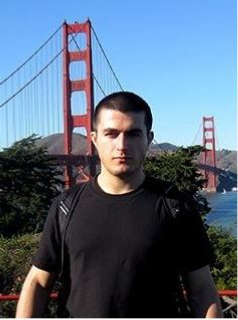Lex Fridman

Lex Fridman
Lex Fridman (born August 15, 1986) is a Russian American YouTuber, Internet celebrity, Scientist, and MIT Researcher. He is passionate about the development of Artificial intelligence. In May 2020, Fridman completed a detailed analysis of Tesla's vehicle deliveries and autopilot statistics. He found that Tesla's vehicles had driven 3.3 billion miles in autopilot. [41][1][2]
Personal Life

Lex's brother is an entrepreneur and CEO at AAPlasma LLC, United States. [5]
The Russian genius does not wear anything other than black and white clothes; either he wears black t-shirts with black trousers or a black business suit with a white shirt.
Lex has short black hair and dark brown eyes.
He is a quiet person who only speaks when necessary.
He is also a singer-songwriter.
Education
He did his schooling in Moscow through a local high school but after that, he moved to the United States.
Lex Fridman received his BS, MS, and Doctor of Philosophy from Drexel University, Philadelphia, Pennsylvania, where he worked on applications of machine learning in behavioral biometric authentication, activity recognition, scene perception, and multi-robot planning and communication systems. [3]
Career
After finishing school, Lex joined Google inc. (2015) in the Research Department as a visiting Researcher in New York City, United States, where he worked on machine learning for large-scale behavior-based authentication before joining MIT.
He is more interested in research work than doing a 9 to 5 job and that is why he started a job as a professor at the Massachusetts Institute of Technology where he worked on applications of machine learning, computer vision, and decision fusion techniques in a number of fields including robotics and human sensing. He teaches Robotics, reinforcement of materials, AI and other topics.
The topic which he is most interested in is “Autonomous vehicles" and he is doing his research in this field and has even worked for Tesla in their autonomous vehicle project.
Lex is particularly interested in understanding human behavior in the context of human-robot collaboration, and engineering learning-based methods that enrich that collaboration.
Lex has been a guest on major podcasts like the Joe Rogan Experience.
He is also the host of an Artificial Intelligence centered podcast and has interviewed Elon Musk on his show. Fridman did an in-depth analysis of Tesla vehicle deliveries, total mileage, and Autopilot mileage and published it on lexfridman.com. In May 2020, Fridman completed a detailed analysis of Tesla's vehicle deliveries and autopilot statistics. He found that Tesla's vehicles had driven 3.3 billion miles in autopilot and 22.5 billion miles in total. He also estimates Tesla delivered 989,861 vehicles in total. This is truly impressive when you consider that Uber had only clocked in around 2 million miles with their autopilot system at this time. [41][42]
His net worth is around $800k and on the rise due to his podcasts and other sources of income.
Besides research and teaching, he enjoys playing guitar, practicing jiu jitsu.
Research and Publications
Some of Lex Fridman Research and Publications are:[7]
Arguing Machines: Human Supervision of Black Box AI Systems. Summary: [8] Framework for providing human supervision of a black box AI system that makes life-critical decisions. They demonstrate this approach on two applications: (1) image classification and (2) real-world data of AI-assisted steering in Tesla vehicles.[9]
Active Authentication on Mobile Devices. Summary: [10] An approach for verifying the identity of a smartphone user with four biometric modalities. They evaluate the approach by collecting real-world behavioral biometrics data from smartphones of 200 subjects over a period of at least 30 days.
Driver Gaze Region Estimation without Use of Eye Movement .
Summary: [11] They propose a simplification of the general gaze estimation task by framing it as a gaze region estimation task in the driving context, thereby making it amenable to machine learning approaches. They went on to describe and evaluate one such learning-based approach. [12]
Driver Frustration Detection from Audio and Video in the Wild. Summary: [14] A method for detecting driver frustration from both video and audio streams captured during the driver's interaction with an in-vehicle voice-based navigation system. An interesting observation: smiles are more common in unsatisfied vs satisfied interactions. [13]
Human Side of Tesla Autopilot: Exploration of Functional Vigilance .
Summary: [15] Large-scale study of driver functional vigilance during Tesla Autopilot assisted driving. The central observations in this work are that drivers in this dataset use Autopilot frequently and yet appear to maintain a relatively high degree of functional vigilance.
Cognitive Load Estimation in the Wild. Summary: Winner of the CHI 2018 Honorable Mention Award. They propose two novel vision-based methods for cognitive load estimation and evaluate them on a large-scale dataset collected under real-world driving conditions. [16]
Human-Centered Autonomous Vehicle Systems .
Summary: [17] They propose a set of shared autonomy principles for designing and building autonomous vehicle systems in a human-centered way, and demonstrate these principles on a full-scale semi-autonomous vehicle. [18]
Deep Traffic .
Summary: Traffic simulation and optimization with deep reinforcement learning. Primary goal is to make the hands-on study of deep RL accessible to thousands of students, educators, and researchers.[19]
Automated Synchronization of Driving Data Using Vibration and Steering Events. Summary: [20] A method for automated synchronization of vehicle sensors using accelerometer, telemetry, audio, and dense optical flow from three video sensors. [21]
MIT Advanced Vehicle Technology Study. Summary: [23] Large-scale real-world AI-assisted driving data collection study to understand how human-AI interaction in driving can be safe and enjoyable. The emphasis is on computer vision based analysis of driver behavior in the context of automation use. [22]
Crowd sourced Assessment of External Vehicle-to-Pedestrian Displays. Summary: 30 external vehicle-to-pedestrian display concepts for autonomous vehicles were evaluated. Simple, minimalist displays performed best.[24]
What Can Be Predicted from 6 Seconds of Driver Glances? Summary: Winner of the CHI 2017 Best Paper Award. They consider a dataset of real-world, on-road driving to explore the predictive power of driver glances. [25]
Tesla Vehicle Deliveries and Autopilot Mileage Statistics .
Summary: Historical data, current estimates, and projections of Tesla vehicle deliveries and Autopilot miles segmented by Autopilot hardware version. [26][27][28]
















